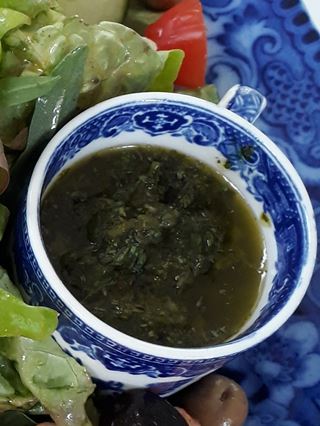Every herb has healing properties so herb pesto isn’t just about making your food taste even better. Herbs stimulate your body to make more antioxidants. But herbs also have a selective antibiotic effect. That is, every herb has action against certain disease-causing bacteria* AND encourages growth of friendly bacteria in your gut. Different herbs discourage different “bad” bugs.
For the most powerful health effects place the pesto in a clean glass/ceramic jar and leave to ferment on the kitchen counter for 2 days before using. The fermentation potentiates the polyphenols (beneficial plant compounds) making them more usable by your body. Using the garlic helps keep the pesto fresher but isn’t essential. If any fluffiness develops on the top of you pesto just scrape it off before using.
The proportions of ingredients to each other don’t really matter so long as you end up with something that’s not too runny.
A generous handful of one fresh herb: Thyme, oregano, parsley, mint, sage, coriander, basil, tarragon, dill are all good. Rosemary is fantastic as well but very strong-tasting – maybe do 1/2 and 1/2 with parsley.
Extra virgin olive oil to bind (1/2-1 cup)
Optional: 2 large cloves freshly crushed garlic
- Wash the herbs, remove any woody stems (for soft herbs like dill, parsley and basil you use the whole stem so long as its soft).
- If using a mini food processor cut the herbs roughly into 2cm lengths then blitz with the garlic and 1/2 cup of the olive oil until you get a paste. If the food processor isn’t catching the herbs you can add more oil to make it all go round.
If making the pesto by hand chop the herbs finely (a mezzaluna or a large knife with a smooth curved blade is good for this). In a bowl mix with the garlic and extra virgin olive oil. - Decant into a clean glass or ceramic jar covered with a saucer, a piece of muslin, or the lid laid loosely on top. Leave at room temperature for 48 hours before starting to eat. It will be fine for a week in the fridge.
Tip: if the pesto starts to go very brown (this happens with basil and coriander) add a thin layer of extra virgin olive oil on top to help preserve the colour.
Good to know:
Did you know that many gut bacteria are normal in certain amounts but toxic if they overgrow. For example the yeast-like fungus known as candida. Small amounts in your gut are normal but when you have a high carbohydrate diet or take antibiotics or acid-blocking drugs candida can take over. It develops a filamentous form (hyphae) which invade your gut lining and cause damage. Food sensitivities, digestive symptoms, autoimmune conditions (e.g. hypothyroidism) and even mood changes can result.

